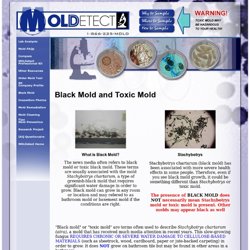

CBN.com - The Christian Broadcasting Network. Mycotoxin. About Black Mold - MOLDetect.com. "Black mold" or "toxic mold" are terms often used to describe Stachybotrys , a mold that has received much media attention in recent years.

This slow-growing mold requires severe water damage to porous materials such as sheetrock, wood, cardboard, paper or jute-backed carpeting) in order to grow. It does NOT grow on bathroom tile but may be found in other areas in a bathroom. Stachybotrys (black mold) spores die quickly after release but, like all mold spores, black mold spores remain allergic and toxic even when dead. In order to eliminate the danger, the mold growth and mold spores themselves must be physically removed, not just treated with a product such as bleach. Chronic exposure to black mold toxins ("toxic mold") has been reported to cause cold or flu symptoms, sore throats, diarrhea, headaches, fatigue, dermatitis, hair loss, general discomfort, and/ or other health-related problems. Researchers believe that infant lung bleeding can be caused by exposure to toxic molds.
Dr. Stachybotrys chartarum. Stachybotrys chartarum, also called Stachybotrys atra, Stachybotrys alternans or Stilbospora chartarum, is a black mold that produces its conidia in slime heads.

It is sometimes found in soil and grain, but the mold is most often detected in cellulose-rich building materials from damp or water-damaged buildings.[1] S. chartarum was originally described from the wall of a house in Prague in 1837 by Czech mycologist August Carl Joseph Corda. It requires high moisture content in order to grow and is associated with wet gypsum material and wallpaper.[2] Medical and veterinary issues[edit] Health problems related to this mold have been documented in humans and animals since the 1930s;[3] it is also considered a likely candidate for the Biblical condition mistranslated as "leprosy", tzaraath.[4] More recently, S. chartarum has been linked with so-called sick building syndrome.
However, the link has not been firmly established in the scientific literature.[5] Detection[edit] See also[edit] Mold - General Information: Facts about Stachybotrys chartarum and Other Molds. I heard about "toxic molds" that grow in homes and other buildings.

Should I be concerned about a serious health risk to me and my family? The term "toxic mold" is not accurate. While certain molds are toxigenic, meaning they can produce toxins (specifically mycotoxins), the molds themselves are not toxic, or poisonous. Hazards presented by molds that may produce mycotoxins should be considered the same as other common molds which can grow in your house. There is always a little mold everywhere - in the air and on many surfaces. In 2004 the Institute of Medicine (IOM) found there was sufficient evidence to link indoor exposure to mold with upper respiratory tract symptoms, cough, and wheeze in otherwise healthy people; with asthma symptoms in people with asthma; and with hypersensitivity pneumonitis in individuals susceptible to that immune-mediated condition. .
A common-sense approach should be used for any mold contamination existing inside buildings and homes. Top of Page Summary. Stachybotrys chartarum. The Joy Of Hope Org - Mold Dichotomy.